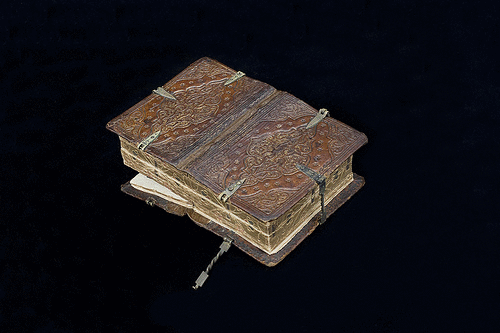
Technology has come so far that we consider it no great achievement when a device the size of a single paper book can contain hundreds, even thousands, of different texts. But 21st-century humanity didn’t come up with the idea of putting multiple books in one, nor did we first bring that idea into being — not by a long shot. Medieval book historian Erik Kwakkel points, for example, to the “dos-à-dos” (back to back) binding of the 16th and 17th centuries, which made for books “like Siamese twins in that they present two different entities joined at their backs: each part has one board for itself, while a third is shared between the two,” so “reading the one text you can flip the ‘book’ to consult the other.”
Not long thereafter, Kwakkel posted an artifact that blows the dos-à-dos out of the water: a 16th-century book that contains no fewer than six different books in a single binding. “They are all devotional texts printed in Germany during the 1550s and 1570s (including Martin Luther, Der kleine Catechismus) and each one is closed with its own tiny clasp,” he writes.
“While it may have been difficult to keep track of a particular text’s location, a book you can open in six different ways is quite the display of craftsmanship.” You can admire it — and try to figure it out — from a variety of different angles at the Flickr account of the National Library of Sweden, where it currently resides in the archives of the Royal Library.
Four or five centuries ago, a book like this would no doubt have impressed its beholders as much as or even more than the most advanced piece of handheld consumer electronics impresses us today. But when the internet discovered Kwakkel’s post, it became clear that this six-in-one devotional captivates us in much the same way as a brand-new, never-before-seen digital device. “With a literacy rate hovering around an estimated 5 to 10 percent of the population during the Middle Ages, only a select few of society’s upper echelons and religious castes had use for books,” Andrew Tarantola reminds us. “So who would have use for a sextuplet of stories bound by a single, multi-hinged cover like this? Some seriously busy scholar.” And he writes that not on a site for enthusiasts of old books, Medieval history, or religious scholarship, but at the temple of tech worship known as Gizmodo.
Related Content:
Wonderfully Weird & Ingenious Medieval Books
Napoleon’s Kindle: See the Miniaturized Traveling Library He Took on Military Campaigns
Wearable Books: In Medieval Times, They Took Old Manuscripts & Turned Them into Clothes
Europe’s Oldest Intact Book Was Preserved and Found in the Coffin of a Saint
Based in Seoul, Colin Marshall writes and broadcasts on cities, language, and culture. His projects include the book The Stateless City: a Walk through 21st-Century Los Angeles and the video series The City in Cinema. Follow him on Twitter at @colinmarshall or on Facebook.


Leave a Reply